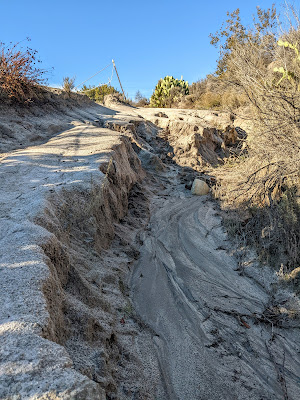A Snake Falls to Earth and Earth Snakes
Edison and Edison Viejo trails are part of a little wedge of tracks
tucked between Whiting Ranch, the Icon headquarters, Aliso Creek trail,
and a new batch of homes called Iron Ridge.
One offshoot trail in this system is rocky and steep, and in the summer I see snakes every time I'm on it. Curled on the warm rocks at the edge of the trail in the mornings, they are slow in the early light, some of them thick as arms.
Today it is winter and there are no snakes on the trail except for Oli the cottonmouth person speaking from my headphones.
Darcie Little Badger's A Snake Falls to Earth is a YA fantasy that deals with everything troubling the millennial to gen Z crowd. Climate change, poor economies, inequitable distribution of wealth, species extinction, displaced or separated families, gender identity, and gun violence are some of the topics examined in the book.
The story shifts between the first person voice of Oli, who begins the book in the mirrored world, and the third person telling of Nina, a young Lipan Apache woman on earth. The voice wavers between whimsical, naive, and the academic sensibilities likely innate to the scientist author.
*Spoilers Follow*
In the shadow world, a species' survival depends on the well-being of its mirror species on earth. Oli's best friend, a toad person, is suddenly at death's door when a climate emergency threatens the existence of an earth toad. This sparks a great quest.
Oli, his friends the coyote sisters, and a hawk person, all travel to earth where they enlist Nina's help to save their toad friend.
The story moves along in fits and bursts, wonderful tangents, and unresolved sub-plots because, as Nina notes, "You know the way these old stories go. Usually there is no single, all encompassing end. There are little resolutions and enduring questions. One story bleeds into the next."
Resolution is reached in the end, though enduring questions do in fact remain. The interspecies band saves the proverbial day and makes two worlds better in the process.
When the Iron Ridge development began I was worried the trails would be ruined, and for a while, they were. Parts were swallowed by the neighborhood, parts inaccessible for years of construction, and parts washed away and overgrown.
But the growth ebbs at times and the washed away parts have left sturdy ridges. The trails are different, but they're back. Running there takes some concentration for the washes, the ridges, and of course the snakes. But, until nature takes them back, I'm glad to be on these tracks.
The Oli chapters of this book are read by Shaun Taylor-Corbett and the Nina chapters by Kinsale Drake (Kinsale Hueston in the credits). It's 10 hours and 37 minutes.


Comments
Post a Comment